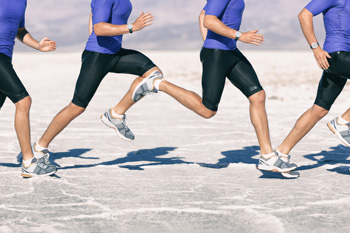
A fractured toe may seem minor, but it can significantly affect balance, stability, and athletic performance. These injuries often occur from direct impact, stubbing the toe, or repetitive stress during sports. Recovery depends on the severity and location of the break, with healing typically taking several weeks. Rest, protective footwear, and sometimes taping or splinting allow the bone to heal properly. Rushing back to sports too soon can delay recovery or lead to re-injury. Once pain and swelling subside, gradual return to movement and strength training helps restore flexibility and coordination. Wearing supportive shoes, and, in some cases, orthotics can reduce pressure on the healing area. If you are an athlete and have a broken toe, it is suggested that you schedule an appointment with a podiatrist before resuming full activity to ensure the toe has healed completely, and to receive guidance on safe re-entry into training and competition.
A broken toe can be very painful and lead to complications if not properly fixed. If you have any concerns about your feet, contact One of our podiatrists from Diagnostic Foot Specialists. Our doctors will treat your foot and ankle needs.
What to Know About a Broken Toe
Although most people try to avoid foot trauma such as banging, stubbing, or dropping heavy objects on their feet, the unfortunate fact is that it is a common occurrence. Given the fact that toes are positioned in front of the feet, they typically sustain the brunt of such trauma. When trauma occurs to a toe, the result can be a painful break (fracture).
Symptoms of a Broken Toe
- Throbbing pain
- Swelling
- Bruising on the skin and toenail
- The inability to move the toe
- Toe appears crooked or disfigured
- Tingling or numbness in the toe
Generally, it is best to stay off of the injured toe with the affected foot elevated.
Severe toe fractures may be treated with a splint, cast, and in some cases, minor surgery. Due to its position and the pressure it endures with daily activity, future complications can occur if the big toe is not properly treated.
If you have any questions, please feel free to contact our offices located in Houston, TX, Houston, TX, and Bryan, TX . We offer the newest diagnostic and treatment technologies for all your foot care needs.

Foot pain can be caused by various factors such as tight muscles, plantar fasciitis, or overuse. To alleviate discomfort, stretching the feet can be a highly effective solution. One of the simplest stretches is the toe stretch, where you sit and pull your toes gently towards your shin, helping to release tension in the foot’s arch and toes. Another effective stretch is the calf stretch, which involves standing facing a wall, placing one foot behind the other, and leaning into the wall to stretch the calf muscles, which can often contribute to foot pain. The plantar fascia stretch can be done by sitting and using a towel or band around the foot to pull the toes back toward you. Regularly incorporating these stretches can help relieve foot pain, improve flexibility, and prevent future discomfort. If you have foot pain, it is suggested that you contact a podiatrist who can treat various foot conditions, and guide you on effective foot stretches.
Stretching the feet is a great way to prevent injuries. If you have any concerns with your feet consult with One of our podiatrists from Diagnostic Foot Specialists. Our doctors will assess your condition and provide you with quality foot and ankle treatment.
Stretching the Feet
Being the backbone of the body, the feet carry your entire weight and can easily become overexerted, causing cramps and pain. As with any body part, stretching your feet can serve many benefits. From increasing flexibility to even providing some pain relief, be sure to give your feet a stretch from time to time. This is especially important for athletes or anyone performing aerobic exercises, but anyone experiencing foot pain or is on their feet constantly should also engage in this practice.
Great ways to stretch your feet:
- Crossing one leg over the others and carefully pull your toes back. Do 10-20 repetitions and repeat the process for each foot
- Face a wall with your arms out and hands flat against the wall. Step back with one foot and keep it flat on the floor while moving the other leg forward. Lean towards the wall until you feel a stretch. Hold for 30 seconds and perform 10 repetitions for each foot
- Be sure not to overextend or push your limbs too hard or you could risk pulling or straining your muscle
Individuals who tend to their feet by regular stretching every day should be able to minimize foot pain and prevent new problems from arising.
If you have any questions please contact our offices located in Houston, TX, Houston, TX, and Bryan, TX . We offer the newest diagnostic and treatment technologies for all your foot and ankle needs.

The foot is a complex structure of bones, joints, and ligaments that work together to absorb shock and propel the body forward while running. Each step places up to three times your body weight on your feet, making them vital for balance and stability. Movements such as eversion, where the foot rolls outward, and inversion, where it rolls inward, help adapt to different surfaces and maintain proper alignment. Overuse or improper running form can strain these bones and lead to injuries. A podiatrist can assess your gait, recommend supportive footwear, and provide treatment for pain or instability. If you have foot or ankle pain from running, it is suggested that you consult a podiatrist who can treat various foot conditions, and guide you on effective running form tips.
If you have any concerns about your feet, contact One of our podiatrists from Diagnostic Foot Specialists. Our doctors can provide the care you need to keep you pain-free and on your feet.
Biomechanics in Podiatry
Podiatric biomechanics is a particular sector of specialty podiatry with licensed practitioners who are trained to diagnose and treat conditions affecting the foot, ankle and lower leg. Biomechanics deals with the forces that act against the body, causing an interference with the biological structures. It focuses on the movement of the ankle, the foot and the forces that interact with them.
A History of Biomechanics
- Biomechanics dates back to the BC era in Egypt where evidence of professional foot care has been recorded.
- In 1974, biomechanics gained a higher profile from the studies of Merton Root, who claimed that by changing or controlling the forces between the ankle and the foot, corrections or conditions could be implemented to gain strength and coordination in the area.
Modern technological improvements are based on past theories and therapeutic processes that provide a better understanding of podiatric concepts for biomechanics. Computers can provide accurate information about the forces and patterns of the feet and lower legs.
Understanding biomechanics of the feet can help improve and eliminate pain, stopping further stress to the foot.
If you have any questions please feel free to contact our offices located in Houston, TX, Houston, TX, and Bryan, TX . We offer the newest diagnostic and treatment technologies for all your foot and ankle needs.

